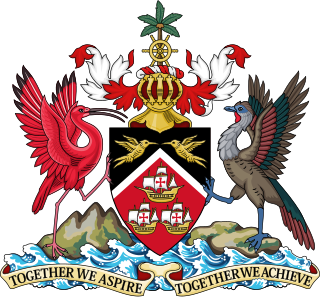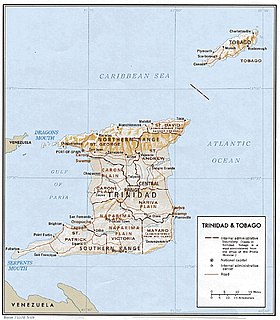Related Research Articles

Port of Spain, officially the City of Port of Spain, is the capital city of Trinidad and Tobago, the country's second-largest city after San Fernando, and the third largest municipality after Chaguanas and San Fernando. The city has a municipal population of 37,074, an urban population of 81,142 and a transient daily population of 250,000. It is located on the Gulf of Paria, on the northwest coast of the island of Trinidad and is part of a larger conurbation stretching from Chaguaramas in the west to Arima in the east with an estimated population of 600,000.

Guardian Media Group plc (GMG) is a British-based mass media company owning various media operations including The Guardian and The Observer. The group is wholly owned by the Scott Trust Limited, which exists to secure the financial and editorial independence of The Guardian in perpetuity.

Persona Communications, formerly Regional Cablesystems, was a cable television, Internet and telecommunications provider in Canada.

James Franklin Hyneman is an American special effects expert who is best known as the co-host of the television series MythBusters alongside Adam Savage where he became known for his distinctive beret and walrus mustache. He is also the owner of M5 Industries, the special effects workshop where MythBusters was filmed. He is known among Robot Wars devotees for his robot entry Blendo, which was deemed too dangerous for entry in the competition. He is the inventor of the Sentry, an unmanned firefighting robotic vehicle. He is also one of the designers of the aerial cable robotic camera system Wavecam used in sports and entertainment events.
Eric A. Williams was a Trinidad and Tobago politician until November 2007 and was Member of Parliament for Port of Spain South. Until his resignation from the Cabinet in January 2006, he served as the Minister of Energy and Energy Industries in the then People's National Movement government, a post he had held since December 2001. A geologist and geophysicist by training, Williams entered Parliament in 1995 when he won the Port of Spain South seat formerly held by PNM founder Dr. Eric Williams.
The Stanford Review is a student-run newspaper that serves Stanford University in Stanford, California. It was founded in 1987 by Peter Thiel and Norman Book.

California 26th congressional district is a congressional district in the U.S. state of California currently represented by Democrat Julia Brownley.

Kevin John William Crossley-Holland is an English translator, children's author and poet. His best known work is probably the Arthur trilogy (2000–2003), for which he won the Guardian Prize and other recognition.
Lifehacker is a weblog about life hacks and software that launched on January 31, 2005. The site was originally launched by Gawker Media and is currently owned by G/O Media. The blog posts cover a wide range of topics including: Microsoft Windows, Mac, Linux programs, iOS and Android, as well as general life tips and tricks. The website is known for its fast-paced release schedule from its inception, with content being published every half hour all day long. The Lifehacker motto is "Tips, tricks, and downloads for getting things done."

The 2006 CONCACAF Women's Gold Cup was the seventh edition of the CONCACAF Women's Gold Cup, and also acted as a qualifier tournament for the 2007 FIFA Women's World Cup. The final tournament took place in the United States between 19 and 27 November 2006. The United States and Canada received byes into the semi-finals of the tournament after contesting the final of the 2002 Gold Cup, while four other spots were determined through regional qualification.

Debunking 9/11 Myths: Why Conspiracy Theories Can't Stand Up to the Facts is a non-fiction book published by Hearst Communications, Inc. on August 15, 2006. The book is based on the article "9/11: Debunking the Myths" in the March 2005 issue of Popular Mechanics and is written by David Dunbar and Brad Reagan, responding to various 9/11 conspiracy theories. The authors interviewed over 300 sources for the book, relying on expert and witness accounts.
John Palmer Croneberger is a retired bishop of the Episcopal Church in the United States of America. He was formerly the ninth bishop of the Diocese of Newark.

This is a list of the National Register of Historic Places listings in Franklin County, Ohio.
Juan de Dios Pérez Quijada is a Panamanian footballer, who plays as a midfielder for Tauro.

The coat of arms of Trinidad and Tobago was designed by a committee formed in 1962 to select the symbols that would be representative of the people of Trinidad and Tobago. The committee included artist Carlisle Chang (1921–2001) and carnival designer George Bailey (1935–1970).
The British Centre for Science Education (BCSE) is a volunteer-run organization in the United Kingdom that has the goal of "countering creationism within the UK" and was formed to campaign against the teaching of creationism in schools.

On the island of Trinidad, the Southern Range is a discontinuous chain of low hills along the southern coast, reaching their highest altitude in the 1,000 feet (300 m) high Trinity Hills of the southeast. According to legend, the sight of the three neighboring hilltops of the then unnamed Trinity Hills, led to Christopher Columbus, on his third voyage to the New World, to name the island, "Trinidad." The broad lowland area on the west between the Southern Range and the Central Range is the Naparima Plain; the lowland area on the east is the Nariva Plain. The Oropuche river flows through the Naparima Plain and drains into the Oropuche Lagoon, a swampy area, on the Gulf of Paria coast, whereas the 31-mile long Ortoire River flows through the Nariva Plain and drains into the Nariva Swamp on the Atlantic Ocean coast. The Southern region of the island has sandy and less fertile soil. The Southern Range, particularly its Western and Central parts, consists of unconsolidated segments.
References
- ↑ Anthony, Michael, Columbus’ three hills a myth Archived 2007-09-26 at the Wayback Machine , Letter to the Editor, Trinidad Guardian , June 11, 2006
- ↑ Boos, Hans, Three peaks — history, not myth Archived 2007-02-13 at the Wayback Machine Letter to the Editor, Trinidad Guardian , June 25, 2006
- ↑ Boos, Hans, More evidence confirms three peaks Archived 2007-09-26 at the Wayback Machine Letter to the Editor, Trinidad Guardian , July 7, 2006